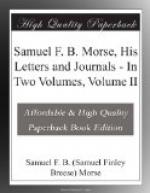Nearly twenty years later, in 1853, Morse referred to this trying period in his career at a meeting of the Association of the Alumni of the University:—
“Yesternight, on once more entering your chapel, I saw the same marble staircase and marble floors I once so often trod, and so often with a heart and head overburdened with almost crushing anxieties. Separated from the chapel by but a thin partition was that room I occupied, now your Philomathean Hall, whose walls—had thoughts and mental struggles, with the alternations of joys and sorrows, the power of being daguerreotyped upon them—would show a thickly studded gallery of evidence that there the Briarean infant was born who has stretched forth his arms with the intent to encircle the world. Yes, that room of the University was the birthplace of the Recording Telegraph. Attempts, indeed, have been made to assign to it other parentage, and to its birthplace other localities. Personally I have very little anxiety on this point, except that the truth should not suffer; for I have a consciousness, which neither sophistry nor ignorance can shake, that that room is the place of its birth, and a confidence, too, that its cradle is in hands that will sustain its rightful claim.”
The old building of the University of the City of New York on Washington Square has been torn down to be replaced by a mercantile structure; the University has moved to more spacious quarters in the upper part of the great city; but one of its notable buildings is the Hall of Fame, and among the first names to be immortalized in bronze in the stately colonnade was that of Samuel F.B. Morse.
CHAPTER XXIII
1835—1837
First exhibitions of the Telegraph.—Testimony of Robert G. Rankin and Rev. Henry B. Tappan.—Cooke and Wheatstone.—Joseph Henry, Leonard D. Gale, and Alfred Vail.—Professor Gale’s testimony.—Professor Henry’s discoveries.—Regrettable controversy of later years.—Professor Charles T. Jackson’s claims.—Alfred Vail.—Contract of September 23, 1837.—Work at Morristown. New Jersey.—The “Morse Alphabet.”—Reading by sound.— first and second forms of alphabet.
In after years the question of the time when the telegraph was first exhibited to others was a disputed one; it will, therefore, be well to give the testimony of a few men of undoubted integrity who personally witnessed the first experiments.
Robert G. Rankin, Esq., gave his reminiscences to Mr. Prime, from which I shall select the following passages:—
“Professor Morse was one of the purest and noblest men of any age. I believe I was among the earliest, outside of his family circle, to whom he communicated his design to encircle the globe with wire....
“Some time in the fall of 1835 I was passing along the easterly walk of Washington Parade-Ground, leading from Waverly Place to Fourth Street, when I heard my name called. On turning round I saw, over the picketfence, an outstretched arm from a person standing in the middle or main entrance door of the unfinished University building of New York, and immediately recognized the professor, who beckoned me toward him. On meeting and exchanging salutations,—and you know how genial his were,— he took me by the arm and said:




